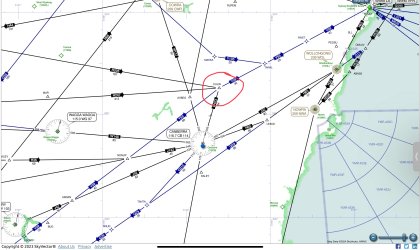I've been flying in and out of Cairns for over 50 years now and I'm pretty sure that we used to occasionally depart from 15 straight down the coastal corridor between the Bellenden Ker and Murray Prior ranges, given the weather conditions being suitable. There is only a slight jink in the valley before the terrain opens up at Cowley. No sharp left turn required and no possible late turn concerns.
As a single aisle passenger I'd prefer that option if the aircraft was experiencing something like what QF520 did last week. Not that my opinion would matter in any way.
On another CNS matter. It's not that long ago that intersection departures used to be the exception. Not any longer. I'm always happier to turn right and back-track a bit for the extra four or five hundred metres.
But in the case of CNS, wouldn’t taking the full length get you airborne 500m earlier and a little more altitude and terrain clearance if needed? And possibly also get you into the turn slightly sooner?
I can definitely see where you're coming from. I would prefer to turn away from high terrain at all costs if the aircraft was still flying well. Over the ocean if gives us a lot more room to fly around. However, until there is some sort of controllability issue, I'd rather not fly up through a valley at low level with possible environmental effects and giving myself a much tighter envelope to fly in while trouble shooting.
The missed approach for the RNP (A GPS based approach) to runway 15 will take us through the valley. But I would have started that manoeuvre from 680ft and 2 miles before the start of runway 15 with 2 engines doing at least 1000fpm in the climb. Very different scenario.
If I take the numbers (24K engines) from the intersection vs the full length, I get almost the exact same V Speeds (V1 is 141kts at B2 vs 142kts at full length). The major difference is the thrust (91.3 at full length vs 93.8 at the intersection) and assumed temperature.
So we would actually be conserving the engines by doing a full length departure. The take off point itself wouldn't make too much of a difference in terms of getting airborne quicker because I effectively have less thrust available to me.
If I was to change that and use full thrust (26K engines) from the full length I get an N1 of 98% and V speeds of 138 (V1), 140 (Vr), 148 (V2). So in this case, yes I would get airborne earlier but now I'm not conserving the engines (not really my problem, I use what I need).
But I would argue here that the take off safety in a jet aircraft is more about the decision making at V1 (go/no go point) and less about the remaining runway available. In both cases the aircraft can accelerate towards V1 make a split decision to reject and then come to a complete stop on the available runway remaining.
We are not going to get airborne and then land back on the same runway with the distance available (even at full length).
As QF520 has shown, it can actually be safer to get the aircraft in the air (it is still safe to fly), secure it properly, give yourself and the airport plenty of time to come together to create a plan and then execute it.
So, is an intersection departure riskier? Not necessarily, from the figures above. What it does do is allow the flow of an airport to be even better and get aircraft departing quicker which is appreciative in a domestic environment.
















